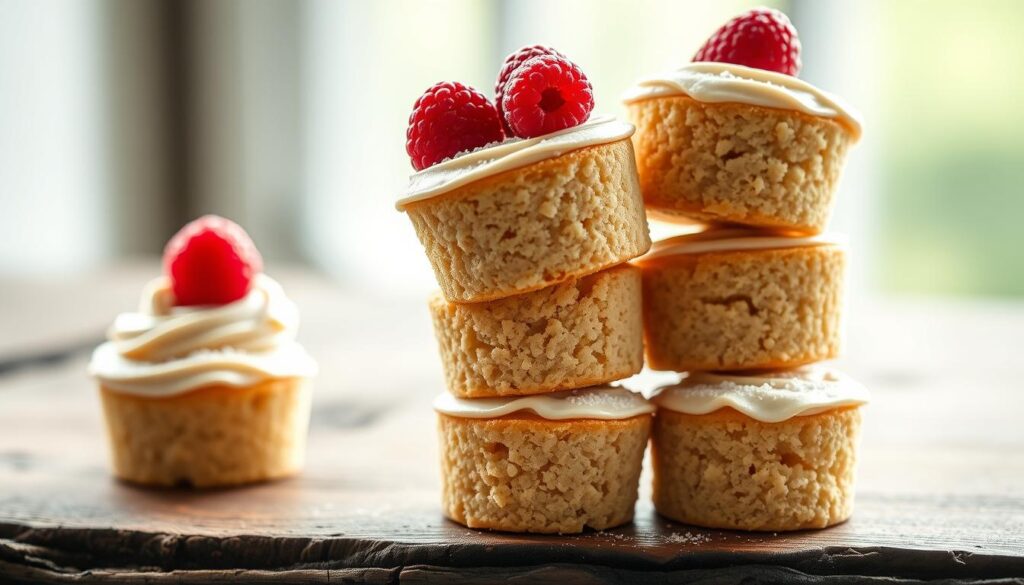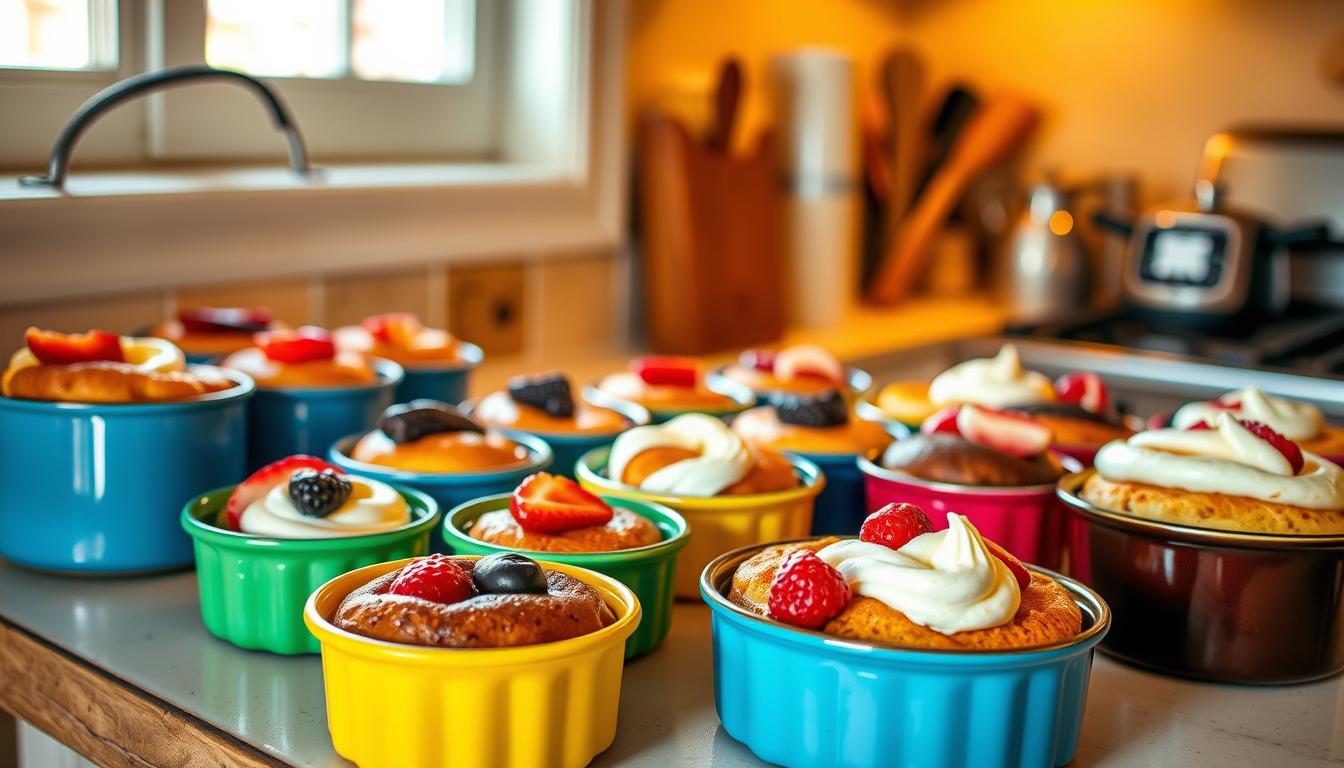Mini cakes are changing dessert time with their small size. They offer personal servings like carrot cake or red velvet, so you don’t have to share. They’re perfect for any event, from Thanksgiving to quick treats ready in 15 minutes.
These desserts are easy to make, store, and decorate. They’re great for parties or when you want something special just for yourself.
Imagine making 12 mini cheesecakes in 35 minutes or 72 citrus mini cakes in 25 minutes. You can try flavors like bourbon-and-Cola glaze or caramelized banana. Mini cakes are perfect for creativity and simplicity.
They’re small, so you waste less and can make more easily. Freeze extras or make a single-serving microwave cake in under 15 minutes.
Table of Contents
Introduction to the World of Mini Cakes
Mini desserts are changing dessert culture, with over 22,000 Instagram posts celebrating them. These small treats, from walnut-sized to a single slice, are redefining celebrations. No more awkward slice divisions or leftover guilt: each mini dessert is a standalone indulgence.
They are perfect for birthdays, weddings, or casual snacks. You can enjoy a chocolate option, a lemon creation, and a vanilla delight all at once.
These small cakes have their roots in Europe’s petit fours. But today, they are loved worldwide. The Maltesse Strawberry Roll Cake, for example, sold 30,000 units in just a month. This shows how much people love compact treats.
Prices range from 7,000 to 16,000 won. You can get a 9,980 won strawberry roll or a luxury option that rivals full-sized Paris Baguette cakes.
- Quick prep: Bake batches in 15–20 minutes instead of an hour.
- Less waste: No leftovers means no guilt.
- Customization: Mix flavors like vanilla, red velvet, or matcha in one order.
Modern trends show 30% more people choosing mini desserts over traditional cakes. Health-conscious bakers prefer their smaller portions to control sugar intake. Innovators also experiment with high-end options over 100,000 won.
Whether you’re craving a sweet snack or hosting a party, these bite-sized wonders offer the perfect balance of indulgence and practicality.
Essential Equipment for Mini Cake Baking
Baking mini cakes or individual cakes requires the right tools. You only need a few basics for consistent results. The most important item is the pan.
Our tests found some brands perform better than others. Nordic Ware’s aluminum pans were a standout. They baked cakes 2⅛ inches tall with little doming. Their size and white finish help prevent overheating, leading to even browning.
- Nordic Ware Aluminum: Lightweight (11 oz) and top-rated, ideal for even baking. Comes with lids and sporks for serving.
- Williams Sonoma Traditional: Leakproof for moist bakes, but cakes were ¼-inch shorter than Nordic Ware’s.
- USA Pan Nonstick: Heaviest (14 oz), but nonstick surfaces caused thicker browning bands, affecting texture.
- Wilton Anodized: Lightest at 4.8 oz, but cakes sank slightly and domed more than others.
Use precise measuring spoons and a cooling rack with your pans. For decorating, get mini spatulas and piping bags. After testing 15 pans over 30 hours, Nordic Ware’s design was the best for individual cakes.
Avoid pans that are too heavy or light. Our results showed weight doesn’t always mean better performance. Choose nonstick coatings for easy cake removal. Consider adding silicone molds for creative shapes. With the right tools, you’ll bake mini cakes that look like they came from a pro.
Basic Ingredients for Perfect Mini Cakes
Choosing the right ingredients is key to perfecting your mini desserts. Each part, from flour to leavening agents, plays a role. Together, they ensure your treats are just right.
Flour Types and Their Effects on Texture
All-purpose flour gives your Vanilla Dream recipe a sturdy base. Cake flour makes layers lighter. Gluten-free flours like almond flour add moisture and a nutty taste.
Remember to measure flour accurately. This prevents your mini desserts from becoming too dry.
Sweeteners: Beyond Granulated Sugar
Try different sweeteners for unique flavors. Brown sugar adds a caramel taste. Honey or maple syrup increase moisture.
For keto diets, sugar substitutes like erythritol keep desserts sweet without extra calories. Be careful with the amounts to get the taste and texture right.
Fats and Oils: Making the Right Choice
Butter is great for chocolate mini treats. Oil, like canola, makes them tender. Coconut oil adds a tropical flavor.
Shortening is good for stable rise in mini desserts baked at 350°F.
Leavening Agents for Mini Bakes
Too much baking powder can cause cakes to fall. Use 1 tsp per cup of flour. Baking soda needs acidity, like buttermilk, to work.
Natural leaveners like sour cream add lift and tang. They help your mini desserts rise evenly without crumbling.
Classic Mini Cake Recipes Everyone Should Master
Starting your baking journey with timeless classics is key. Mini cakes are both classic and versatile, perfect for any event. Mastering these three recipes will guarantee success every time.
| Recipe | Key Features | Total Time | Servings |
|---|---|---|---|
| Vanilla Mini Cakes | Moist crumb, adaptable to frostings | 40 mins | 12 |
| Chocolate Mini Cakes | Velvety texture with dark cocoa | 1 hour | 15 |
| Lemon Mini Cakes | Zesty zest blend, bright citrus finish | 50 mins | 10 |
Start with vanilla for a clean taste. Add sprinkles or caramel for a personal touch. Chocolate mini cakes use dark cocoa for a rich flavor, paired with ganache or peanut butter.
Lemon mini cakes stand out with fresh zest and a sugar glaze.
- Vanilla: Mix butter, eggs, and buttermilk for a tender crumb.
- Chocolate: Combine espresso powder for enhanced richness.
- Lemon: Add blueberries or lavender for seasonal twists.
These desserts keep well in airtight containers. For lemon, reduce sugar to taste. Try layering raspberry jam in chocolate mini cakes for a unique touch.
Creative Flavor Combinations for Unique Mini Cakes
Make your tiny confections stand out with bold, new flavor mixes. These pairings turn simple petite treats into exciting culinary journeys. Try mixing sweet and savory, like caramel on sea salt cakes or dark chocolate with orange.
- Caramel & Sea Salt: Add salted caramel to warm mini bundts for a sweet and salty mix.
- Lemon-Lavender: Add lemon zest and dried lavender to shortbread for a spring touch.
- Cookie Butter Trio: Mix peanut and cookie butter with pecans for a crunchy treat.
- Spiced Chocolate: Add bourbon-soaked raisins to chocolate ganache for a boozy twist in winter petite treats.
Try seasonal flavors like blueberry-lemon for summer or apple-cinnamon for fall. They make gifts and event menus special. Mix textures, like gooey chocolate in red velvet or crushed graham crackers on cheesecakes. Even classics like carrot cake get a new twist with coconut buttercream.
Let your imagination lead. Start small, test flavors, and adjust sweetness. These tips turn simple baking into unforgettable tiny confections that wow everyone.
Seasonal Mini Cake Ideas for Year-Round Enjoyment
Make your kitchen a year-round party with mini desserts for every season. These small cakes let you try new flavors like zesty citrus in spring or autumn spices. Plus, they’re just the right size.
Spring Fruit Mini Cakes
Spring’s freshness comes alive in mini desserts like rhubarb cakes or lemon-poppyseed bites. Grapefruit-infused batters add a bright twist. Food stylist Torie Cox suggests adding edible flowers like violets or pansies for a floral touch.
Summer Berry Celebrations
Stay cool with no-bake berry compote-topped cheesecakes (use muffin pans for easy serving). Blueberry-lavender or raspberry-lemonade small cakes are perfect for summer gatherings.
Fall Spice Mini Cakes
Autumn recipes feature warm spices like cinnamon and nutmeg. Try pumpkin-spice cakes with maple glaze or apple-cranberry options. A 325°F bake time keeps them moist.
Winter Holiday Mini Treats
Enjoy peppermint-white chocolate swirls or eggnog-infused cakes with candied ginger. Cranberry-orange mini cakes offer a festive yet light choice.
“Zingy grapefruit balances the rich sweetness of the cake batter.” – Antonis Achilleos, Chef
| Nutritional Highlights | Per Serving |
|---|---|
| Calories | 863 |
| Total Fat | 55g |
| Sugar | 46g |
| Protein | 18g |
Match your small cakes with seasonal decor—think pumpkin molds in fall or snowflake sprinkles in winter. Use gluten-free flour for dietary needs, ensuring great flavor.
The Art of Mini Cake Decoration
Decorating individual cakes is all about precision. It’s about finding the right balance between style and size. Imagine drizzling silky frosting over a carrot cake’s surface, then sprinkling toasted coconut for a touch of elegance. These tiny confections need special techniques to make each piece a miniature masterpiece.
First, learn simple frosting methods. Use a small piping bag for precise details:
- Swirl buttercream into delicate rosettes with a #3 piping tip.
- Drizzle glaze using a spoon for a glossy finish.
- Spread frosting thinly with an offset spatula for a smooth look.
Simple Frosting Techniques
Start with a stable base: chill cakes briefly before frosting. For a rustic feel, drag a fork through the frosting surface. Try flavors like matcha or caramel for standout tiny confections.
Working with Fondant on Small Surfaces
Roll fondant to 1/16-inch thickness. Use a toothpick to smooth edges against the cake’s sides. Avoid overworking the dough to prevent cracking. Try these pro tips:
- Dust your workspace lightly with cornstarch.
- Trim excess fondant with sharp scissors.
- Add details using edible markers or edible glitter.
Edible Decorations That Impress
Choose decorations that match the cake’s size. Use this guide to pick the right embellishments:
| Decoration | Best For | Pro Tip |
|---|---|---|
| Edible gold leaf | Elegant events | Use tweezers to place leaf fragments. |
| Mini chocolate shavings | Rich flavors | Shave dark chocolate with a vegetable peeler. |
| Edible pearls | Modern designs | Arrange in clusters for visual impact. |
Remember, less is more. A single fresh rose petal or a dusting of matcha powder can elevate any individual cake without overcrowding the surface.
Vegan and Gluten-Free Mini Cake Alternatives
Make sure everyone can enjoy mini cakes with tasty, easy-to-make options. Vegan and gluten-free recipes offer bite-sized desserts that are fun for all. Replace eggs with flaxseed or egg substitutes, and use coconut or oat milk for a creamy touch.
- Use almond flour and tapioca flour blends for structure in gluten-free batters
- Maple syrup or agave sweeten recipes while maintaining moisture
- Xanthan gum can stabilize mixtures, but some recipes achieve texture with rice flour alone
A quick recipe takes just 25 minutes. It mixes Dutch cocoa, rice flour, and coconut milk for a rich taste. Top it with vegan buttercream from coconut butter and plant milk. Each piece has 336 calories, with 13g of natural sugars from maple syrup. Over 23K bakers have loved this recipe, showing it’s both healthy and delicious.
« My guests couldn’t tell they were gluten-free! » – @SweetEatsBlogger
For frosting, try cashew butter or coconut cream. Always chill cakes 10-20 minutes before decorating to avoid crumbling. These changes work great in 10cm tins, making perfect portions. These mini cakes show that everyone can enjoy, without giving up flavor.

Tips for Baking Perfect Mini Cakes Every Time
Mastering small cakes needs focus on details. First, preheat your oven to 300°F (150°C) for even baking. Use digital scales to measure batter accurately. Here’s what works best:
| Cake Type | Batter Weight |
|---|---|
| Liquid batters (e.g., chocolate) | 90g |
| Butter-based (e.g., Victoria sponge) | 100g |
| Carrot cake | 110g |
| Brownies | 120-130g (fill 2/3 full) |
- Use two medium scoops of batter per tin. Overfilling causes overflow and uneven cooking.
- Check for doneness 5 minutes early than full-sized recipes. Insert a skewer—clean means done.
- Let mini cakes cool 5 minutes in the tin before transferring to a rack.
Common issues? Here’s how to fix them:
- Doming: Reduce oven temp by 10°F or bake 2 minutes less.
- Sticking: Grease pans with shortening and parchment liners.
- Dryness: Add 1 tsp extra liquid per 12 mini cakes.
Pro tip: Store unbaked batter in the fridge for up to 24 hours. Freeze baked mini desserts for 2 weeks—thaw at room temp for 1 hour before decorating. Need efficiency? A standard batch of Vanilla Dream Cakes yields 18 total (12 vanilla, 6 chocolate) with zero waste. Adjust mix ratios using boxed cake mixes for consistent leavening power. Remember: consistency ensures every mini dessert turns out perfectly!
From Cake Pops to Petit Fours: Exploring Tiny Confections
Creativity has no bounds when it comes to tiny treats. Whether you’re making cake pops or petit fours, there’s endless fun. These small delights are perfect for any event, combining taste, look, and ease.
The Cake Pop Revolution
Cake pops changed the dessert scene by mixing fun and ease. They’re easy to hold, making them great for parties. To make them, crumble cake, mix with frosting, and coat in chocolate or caramel.
Pro tip: Use a piping bag for a smooth finish. Their glossy look is perfect for Instagram.
Elegant Petit Fours
French-inspired petit fours need precision. Layer sponge cakes with jam or buttercream, then glaze with fondant. Add piped borders for a touch of elegance.
They’re perfect for weddings or fancy events. Enjoy them with tea or coffee for a special treat.
Mini Bundt Cakes and Shaped Varieties
Mini bundts are a breeze to make and look great. Use rich chocolate batter and drizzle with bourbon ganache for extra flavor. Their shape holds glazes well, and they’re quick to prepare.
Choosing between these treats depends on your event. Cake pops are fun, while petit fours are fancy. Mini bundts offer both style and simplicity. Try different flavors and textures to find your favorite. Remember, even small treats pack a big punch!
Serving Ideas for Individual Cakes at Parties
Individual cakes and petite treats make parties easy. They’re perfect for sharing and cut down on waste. Place them on tiered stands or colorful platters for a great look. For themed parties, group similar flavors like pumpkin or peppermint.
Set up a dessert bar where guests can make their own mini cakes. Offer toppings like maple whipped cream or fresh fruits. Use clear labels to show flavors and dietary info, helping guests with allergies or special diets.
- Tiered displays: Stack petit fours on glass tiers for elegance.
- Seasonal pairings: Pair citrus mini cakes with mint sprigs in summer.
- Buffet stations: Arrange 12 mini cheesecakes per dozen on chilled trays.
For casual gatherings, create a grazing table with 30 small treats. Use ribbons in matching colors for a seasonal look. Remember, 60% of hosts now offer gluten-free or vegan options.
Pro tip: Bake mini chocolate lava cakes in ramekins and keep them warm in a slow cooker. Store leftovers in airtight containers for up to 24 hours.
Whether you’re hosting 10 or 100 guests, individual cakes are a hit. They’re easy to serve and save time, making them perfect for busy events.
How to Package and Gift Your Mini Cakes
When giving mini desserts as gifts, look at both how they look and how they’re packed. Good packaging keeps your treats fresh and makes a great impression. Here’s how to turn your homemade goodies into gifts to remember.

| Packaging Type | Best For | Eco-Friendly Options |
|---|---|---|
| Cellophane sleeves | Individually wrapped mini desserts | Compostable cellophane |
| Bakery boxes | Layered or delicate mini desserts | Recycled cardboard containers |
| Mason jars | Cheesecakes or molten lava centers | Reusable glass jars with plantable seed labels |
Choose packaging that’s both stylish and protective. For mini desserts like bite-sized desserts, consider:
- Non-slip pads to keep layers in place
- Airtight containers for items that need to stay dry
- Clear labels with how to store them
Want to make gift sets? Mix flavors like red velvet, caramel, and lemon in themed boxes. Add a card with serving tips and allergy warnings. For shipping, follow these steps:
- Wrap cakes in parchment paper then foam sheets
- Use insulated boxes with cold packs for perishables
- Ship via overnight delivery to keep them fresh
“Mini cakes eliminate the need for sharing—each guest gets their own perfect portion.”
Professional packaging is easy to do. Start with our mini desserts label template for a polished look. Remember to keep boxed items chilled until they’re delivered. Tell the recipient to chill them for 1.5 hours before eating. With these tips, your mini desserts will arrive as delicious as they were when you made them.
Storage Solutions to Keep Your Bite-Sized Desserts Fresh
Keeping your tiny treats fresh is key. They should stay moist, tasty, and look great. Here’s how to keep them fresh without losing quality:
-
- Freeze unbaked batter: Pour vanilla dream cake batter into molds, freeze until solid, then transfer to airtight containers. Bake straight from the freezer for convenience.
- Store baked unfrosted cakes:
Wrap each cake in parchment, then plastic wrap. Put them in labeled containers for up to 3 months. Thaw at room temperature before frosting.
-
- Refrigerate perishable fillings:
Cakes with cream cheese or whipped cream frostings need to be in sealed containers in the fridge. Eat them within 2 days.
-
- Room-temperature storage:
Items like chocolate-dipped mini bundt cakes stay fresh 1-2 days at room temperature. Use airtight containers to keep them moist.
Always use resealable plastic containers to protect delicate decorations. Layer items with parchment to avoid crushing. For event displays, remember 85% of planners agree presentation matters—so store in clear containers to maintain visual appeal. Avoid refrigerating uncovered desserts, as odors can seep in. When freezing decorated cakes, wrap in parchment first, then foil to prevent condensation damage during thawing.
Mini Cakes Around the World: International Inspirations
Exploring global traditions can turn your baking into a journey around the world. From Parisian patisseries to Japanese tea houses, small cakes are cherished everywhere. Let’s look at three iconic styles and their special techniques.
French Petit Gâteaux
French pastry chefs, like Cédric Grolet (Le Meurice’s executive pastry chef), are experts in layered petit gâteaux. These small cakes mix genoise sponge, buttercream, and fruit coulis. Try making your own version to see their delicate texture and flavor.
British Tea Cakes
British tea cakes, like mini Victoria sponges or individual cakes like fondant fancies, are perfect for afternoon tea. Brands like Sincerely, Sam Cakes even make them for special events. They show how timeless these treats are.
Japanese-Inspired Mini Cakes
Japanese wagashi and cheesecake miniatures focus on simplicity and using seasonal ingredients. Dorayaki (red bean paste-filled) or fluffy cheesecakes in tiny tins show this minimalist art. Amy Yip of Yip Studio in Brooklyn brings these styles to modern tastes.
| Country | Culinary Specialty | Signature Feature |
|---|---|---|
| France | Petit gâteaux | Multi-layered construction |
| United Kingdom | Tea cakes | Light, moist crumb |
| Japan | Dorayaki | Seasonal fillings |
Global flavors can inspire your baking. Try Indonesian lapis legit’s layered design or Portuguese pastel de nata mini tarts. These traditions show that small cakes carry big cultural significance. Experiment with international ingredients like matcha or lavender to add authenticity to your creations.
Scaling Down Regular Cake Recipes to Create Perfect Mini Versions
Bakingmini cakesis more than just making ingredients smaller. It’s about keeping the taste and texture right. First, figure out the right amounts: cut down flour, sugar, and liquids by the right ratio. For example, a 9-inch cake recipe becomes 2 cups for 4-inch pans.
Remember, modern cake mixes have less than before. This is to avoid cakes turning out dry. So, make sure to adjust the ingredients carefully.
- Divide leavening agents carefully—reduce baking powder/soda by 20% to prevent sinking.
- Use 4-inch pans for even baking (18–22 minutes) or 6-inch pans (24–28 minutes).
- Test doneness early: check with a toothpick at 40 minutes for layered cakes.
Try adding ½ cup all-purpose flour if mixes are too small. For example, a classic vanilla recipe might need 2 boxed mixes plus 3 extra ounces. Always chill crumb coats for 20+ minutes to lock in structure.
Pro tip: When adapting chocolate recipes, cut cocoa powder by 1/8 cup and use ¼ tsp vanilla extract for flavor balance. Store leftovers in airtight containers—raspberry buttercream stays fresh up to 2 weeks refrigerated.
Test batches first to track changes. Note how spices like cinnamon or extracts might taste stronger in small batches. Keep a log of tweaks to perfect yourindividual cakesevery time. Adjusting recipes systematically ensures consistent results whether making 12 mini cupcakes or a 6-inch layer.
Conclusion: Embracing the Joy of Mini Cake Baking
Mini cakes have come a long way from their 19th-century roots. They started in American cookbooks in the 1820s. The invention of baking powder in the 1840s made them even more popular. Today, they are a mix of tradition and innovation, with flavors and designs that wow.
They’re also loved for being practical. Mini cakes help you control your portions, which is great for those watching their diet. They come in gluten-free and vegan options, catering to different dietary needs. The demand for these options shows in the $7.59 billion gluten-free market.
They’re also good for the planet. Eco-friendly packaging and using local ingredients are becoming more common. Plus, their small size lets you try new things without wasting ingredients. Whether you’re making cake pops or themed mini cakes, each batch is a chance to be creative.
Baking mini cakes is for everyone. Beginners can make delicious, beautiful treats, while experts can show off their skills. They’re perfect for any event, from weddings to birthdays. With trends like botanical flavors and hidden surprises, there’s always something new to try. Start with simple recipes and then get adventurous. Every mini cake or cake pop you make is a celebration of your creativity and the joy of sharing.

